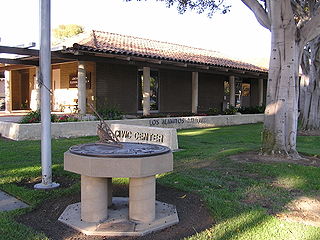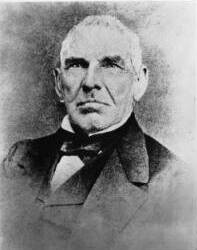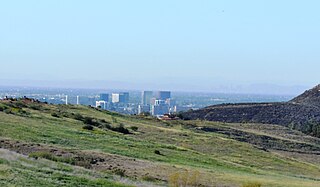Related Research Articles

Los Alamitos is a city in Orange County, California. The city was incorporated in March 1960. The population was 11,780 at the 2020 census, up from 11,449 at the 2010 census. The adjacent unincorporated community of Rossmoor uses the same 90720 ZIP code in its mailing address, but is not part of the city. The Los Alamitos Race Course is named for the city, but lies in the neighboring city of Cypress.

The Irvine Company LLC is an American private company focused on real estate development. It is headquartered in Newport Beach, California, with a large portion of its operations centered in and around Irvine, California, a planned city of more than 300,000 people mainly designed by the Irvine Company. The company was founded by the Irvine family and is currently wholly owned by Donald Bren.

The recorded history of the Newport Beach, California region began when the area was first explored by Europeans in the 1500s. Prior to that time, Native Americans such as the Tongva and Juaneño/Luiseño people had been living in the area for thousands of years. Explorer Juan Rodriguez Cabrillo mapped the coastline in 1542, but it was 200 years before Europeans settled the area. In 1769, Newport was a small portion of the land grant of Don José Antonio Yorba I, first under Spanish and then Mexican rule. After the Civil War, the land was developed by American settlers: for ranching by James Irvine and for shipping by James McFadden. A small settlement was built around McFaddens’ Wharf and it became the largest business of Orange County, California. Following the opening of the San Pedro Harbor in Los Angeles in 1899, the commercial shipping industry in Newport declined. Newport Beach developed into a tourist and recreational boating community. in August 1906, Newport Beach became incorporated as a city.

William Welles Hollister (1818–1886) was a native of Ohio who came west in the 1850s and became a wealthy rancher and entrepreneur in California.

Rancho San Justo was a 34,620-acre (140.1 km2) Mexican land grant in present-day San Benito County, California given in 1839 by Governor Juan B. Alvarado to José Antonio Castro. The lands of the rancho include current day Hollister.

Irvine is a master-planned city in southern Orange County, California, United States, in the Los Angeles metropolitan area. The Irvine Company started developing the area in the 1960s and the city was formally incorporated on December 28, 1971. The 66-square-mile (170 km2) city had a population of 307,670 at the 2020 census, it is the 63rd most populous city in the United States.
The James Irvine Foundation is a philanthropic nonprofit organization that provides grants to other organizations in California.

Don Juan Temple was a Californian ranchero and merchant. Born in Massachusetts, he emigrated to Alta California in 1827, becoming a Mexican citizen, adopting the Spanish language and a Spanish name, and eventually marrying into a prominent Californio family. After acquiring Rancho Los Cerritos in 1843, he became one of the largest landowners in Los Angeles County.

Rancho San Joaquin, the combined Rancho Cienega de las Ranas and Rancho Bolsa de San Joaquin, was a 48,803-acre (197.50 km2) Mexican land grant in the San Joaquin Hills, within present-day Orange County, California.
Rancho Lomas de Santiago was a 47,227-acre (191 km2) Mexican land grant given by Mexican Governor Pío Pico to Teodosio Yorba in 1846. The name means "Hills of St. James". The rancho included parts of present-day Irvine and Tustin in what is now eastern Orange County, California.
Rancho Los Cerritos was a 27,054-acre (109.48 km2) 1834 land grant in present-day southern Los Angeles County and Orange County, California The grant was the result of a partition of the Rancho Los Nietos grant. "Cerritos" means "little hills" in Spanish. The rancho lands include the present-day cities of Cerritos and Long Beach.
Rancho Santa Paula y Saticoy was a 17,773-acre (71.92 km2) Mexican land grant in the Santa Clara River Valley, in present-day Ventura County, California, and granted in 1843 by Governor Manuel Micheltorena to Manuel Jimeno Casarin. The rancho lands include the modern communities of Saticoy and Santa Paula along the Santa Clara River.
Rancho Punta de la Concepcion was a 24,992-acre (101.14 km2) Mexican land grant in the northern Santa Ynez Mountains, in present day Santa Barbara County, California. It was granted by Governor Juan Alvarado in 1837, to Anastacio Carrillo. The grant extended along the Pacific coast from Point Arguello south to Cojo Creek, just east of Point Conception.
Rancho Niguel was a 13,316-acre (53.89 km2) Mexican land grant in the San Joaquin Hills, within present-day Orange County, California.
James Stephen Rice (1846–1930) was an American businessman and rancher who was a pioneering resident of Orange County, California and a civic leader in Tustin, California.
The Bixby family is an American family that was heavily involved in the development of California ranches and real estate in the 19th and 20th centuries. Through various companies, they controlled at one time or another large swathes of California real estate, much of it derived from Mexican land grants. Over several generations, their holdings included Rancho Los Cerritos and Rancho Los Alamitos, and parts of Rancho San Justo and Rancho Palos Verdes, totaling well over 100,000 acres. Parts of the towns of Long Beach, Bellflower, Paramount, Signal Hill, Lakewood, and Los Alamitos emerged from former Bixby-held lands. Within Long Beach, the neighborhoods Bixby Hill, Bixby Knolls, and Bixby Village are named after the family, as well as Bixby Park in the Alamitos Beach neighborhood.

Bommer Canyon is an open space preserve in southern Irvine, California featuring hiking and biking trails as well as private event areas. The canyon is part of the Irvine Ranch, which itself is a National Natural Landmark, the first California Natural Landmark, and part of the City of Irvine Open Space Preserve. The preserve is adjacent to the affluent Irvine villages of Shady Canyon and Turtle Ridge and features roughly 16,000 acres of preserved open space. Approximately 15 of these acres are preserved as a "Cattle Camp" named for the area's previous cattle operations and are now rented for private events such as campouts, company picnics, and family reunions. The trails in Bommer Canyon feature groves of oak and sycamore trees as well as rough rock outcrops and are popular with area residents who use them for nature walks, hiking and mountain biking.
Athalie Anita Irvine, known as Joan Irvine Smith, was an American philanthropist, arts patron, horse trainer and heiress to the Irvine family fortune from their California ranch.
Sarah Bixby Smith (1871–1935) was a California writer and an advocate of women's education. Adobe Days, her memoir of growing up in southern California, is considered a classic of the genre.
The Bixby land companies were a group of California-based land companies founded by various members of the Bixby and Flint families from Maine. In the late 19th and early 20th centuries, the firms of Flint, Bixby & Company, J. Bixby & Company, J. W. Bixby & Company, the Alamitos Land Company, and the Bixby Land Company controlled large swathes of California real estate, much of it derived from Mexican land grants. At various times their holdings included Rancho Los Cerritos, Rancho Los Alamitos, half of Rancho San Justo, and part of Rancho Palos Verdes together with other property in San Benito, Santa Barbara, and Los Angeles counties. Parts of the towns of Long Beach, Bellflower, Paramount, Signal Hill, Lakewood, and Los Alamitos emerged from former Bixby-held lands.
References
- ↑ Guide to the Rice Family Papers
- ↑ Notables Of The West V2: Being The Portraits And Biographies Of The Progressive Men Of The West, 1915, by International News Service
- 1 2 Herringshaw, Thomas William. American Elite and Sociologist Bluebook, p. 293. American Blue Book Publishers, 1922.
- ↑ Cleland, Robert Glass. The Irvine Ranch of Orange County: 1810-1950. San Marino, Calif.: The Huntington Library, 1952, p. 147.
- ↑ James Irvine II
- ↑ Marble, Steve (2019-12-20). "Joan Irvine Smith, daughter of O.C. land baron who helped establish UC Irvine, dies at 86". Los Angeles Times. Retrieved 2019-12-20.
- ↑ Myford Plum Irvine @ find a grave
- ↑ Brower, Martin A (1994). The Irvine Ranch : a time for people : a 50-year overview of the development of the Irvine Ranch. ISBN 978-0-9641326-0-3.
- ↑ Cleland, Robert Glass (2003). The Irvine Ranch. The Huntington Library Classics. ISBN 978-0-87328-015-0.